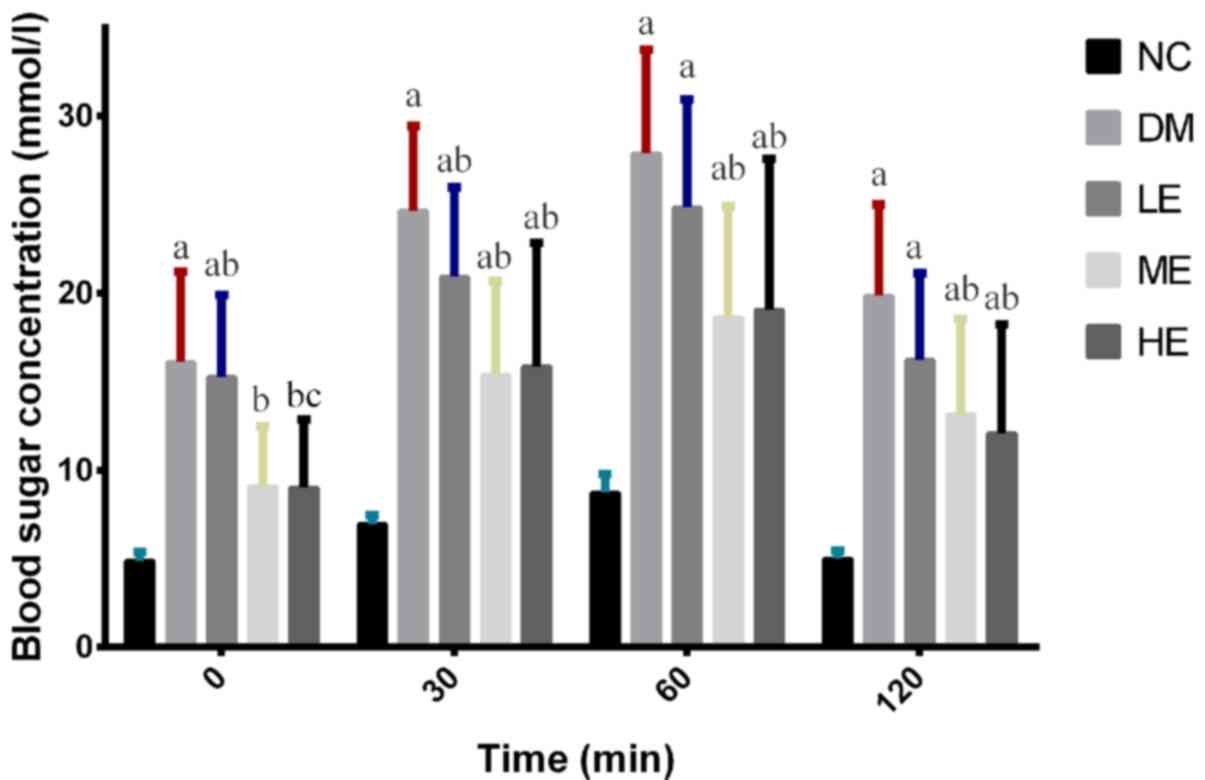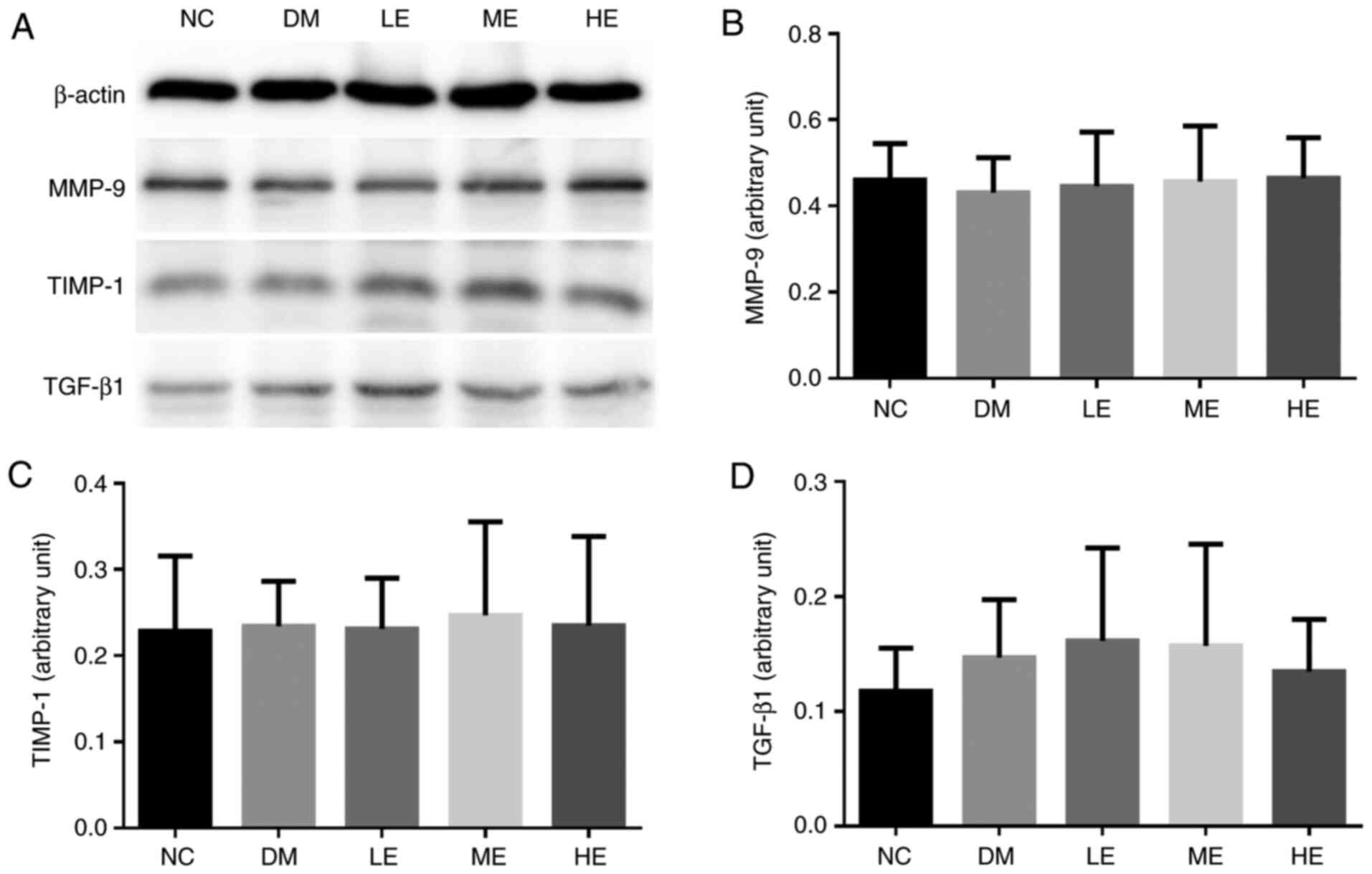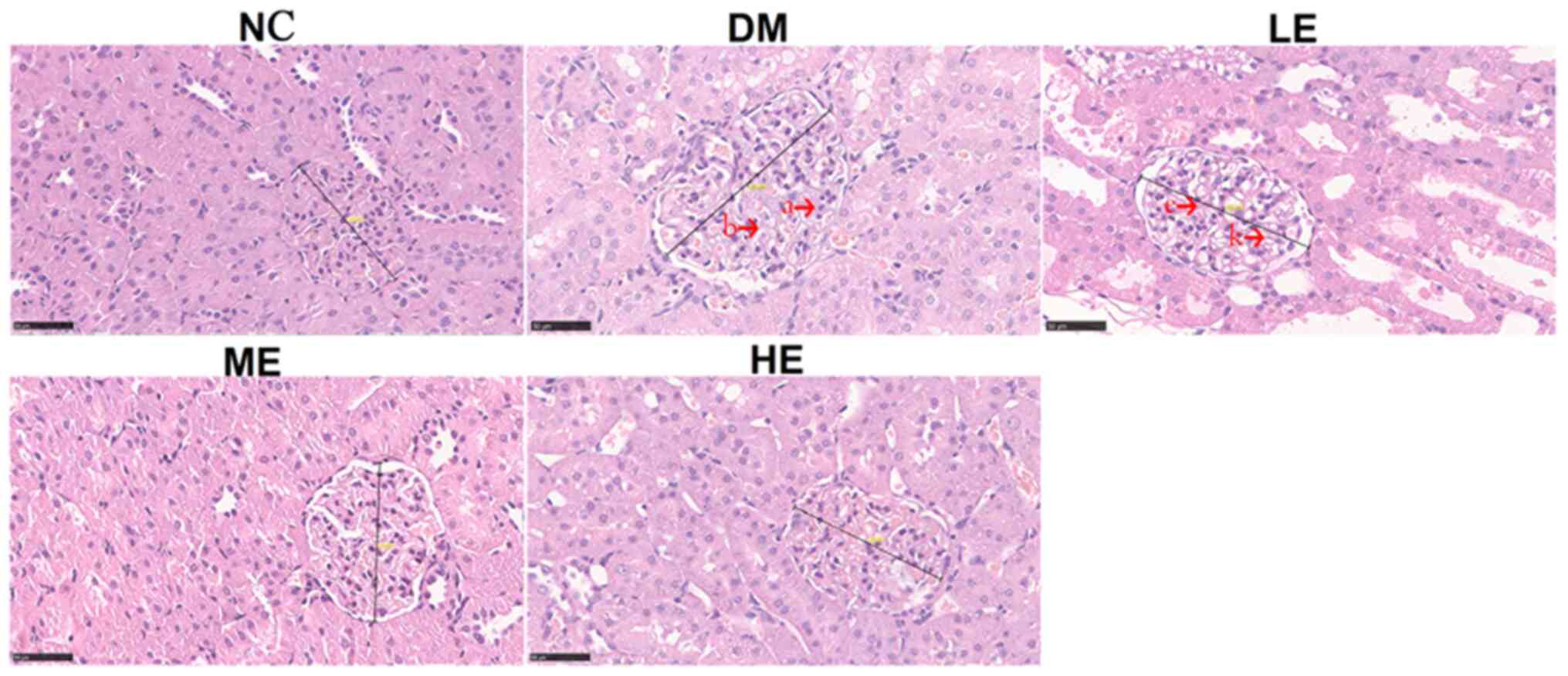|
1
|
Green A, Christian Hirsch N and Pramming
SK: The changing world demography of type 2 diabetes. Diabetes
Metab Res Rev. 19:3–7. 2003.PubMed/NCBI View
Article : Google Scholar
|
|
2
|
Zimmet P: Globalization, coca-colonization
and the chronic disease epidemic: Can the Doomsday scenario be
averted? J Intern Med. 247:301–310. 2000.PubMed/NCBI View Article : Google Scholar
|
|
3
|
Zimmet P, Alberti KG and Shaw J: Global
and societal implications of the diabetes epidemic. Nature.
414:782–787. 2001.PubMed/NCBI View
Article : Google Scholar
|
|
4
|
Rask-Madsen C and King GL: Vascular
complications of diabetes: Mechanisms of injury and protective
factors. Cell Metab. 17:20–33. 2013.PubMed/NCBI View Article : Google Scholar
|
|
5
|
Piccoli GB, Grassi G, Cabiddu G, Nazha M,
Roggero S, Capizzi I, De Pascale A, Priola AM, Di Vico C, Maxia S,
et al: Diabetic kidney disease: A syndrome rather than a single
disease. Rev Diabet Stud. 12:87–109. 2015.PubMed/NCBI View Article : Google Scholar
|
|
6
|
Jha JC, Banal C, Chow BS, Cooper ME and
Jandeleit-Dahm K: Diabetes and kidney disease: Role of oxidative
stress. Antioxid Redox Signal. 25:657–684. 2016.PubMed/NCBI View Article : Google Scholar
|
|
7
|
Huang K, Chen C, Hao J, Huang J, Wang S,
Liu P and Huang H: Polydatin promotes Nrf2-ARE anti-oxidative
pathway through activating Sirt1 to resist AGEs-induced
upregulation of fibronetin and transforming growth factor-β1 in rat
glomerular messangial cells. Mol Cell Endocrinol. 399:178–189.
2015.PubMed/NCBI View Article : Google Scholar
|
|
8
|
Hu C, Sun L, Xiao L, Han Y, Fu X, Xiong X,
Xu X, Liu Y, Yang S, Liu F and Kanwar YS: Insights into the
mechanisms involved in the expression and regulation of
extracellular matrix proteins in diabetic nephropathy. Curr Med
Chem. 22:2858–2870. 2015.PubMed/NCBI View Article : Google Scholar
|
|
9
|
Duran-Salgado MB and Rubio-Guerra AF:
Diabetic nephropathy and inflammation. World J Diabetes. 5:393–398.
2014.PubMed/NCBI View Article : Google Scholar
|
|
10
|
Yeo ES, Hwang JY, Park JE, Choi YJ, Huh KB
and Kim WY: Tumor necrosis factor (TNF-alpha) and C-reactive
protein (CRP) are positively associated with the risk of chronic
kidney disease in patients with type 2 diabetes. Yonsei Med J.
51:519–525. 2010.PubMed/NCBI View Article : Google Scholar
|
|
11
|
Campion CG, Sanchez-Ferras O and Batchu
SN: Potential role of serum and urinary biomarkers in diagnosis and
prognosis of diabetic nephropathy. Can J Kidney Health Dis.
4(2054358117705371)2017.PubMed/NCBI View Article : Google Scholar
|
|
12
|
Dalla Vestra M, Mussap M, Gallina P,
Bruseghin M, Cernigoi AM, Saller A, Plebani M and Fioretto P:
Acute-phase markers of inflammation and glomerular structure in
patients with type 2 diabetes. J Am Soc Nephrol. 16 (Suppl
1):S78–S82. 2005.PubMed/NCBI View Article : Google Scholar
|
|
13
|
Moon JY, Jeong KH, Lee TW, Ihm CG, Lim SJ
and Lee SH: Aberrant recruitment and activation of T cells in
diabetic nephropathy. Am J Nephrol. 35:164–174. 2012.PubMed/NCBI View Article : Google Scholar
|
|
14
|
Sigal RJ, Kenny GP, Wasserman DH and
Castaneda-Sceppa C: Physical activity/exercise and type 2 diabetes.
Diabetes Care. 27:2518–2539. 2004.PubMed/NCBI View Article : Google Scholar
|
|
15
|
Bedford TG, Tipton CM, Wilson NC, Oppliger
RA and Gisolfi CV: Maximum oxygen consumption of rats and its
changes with various experimental procedures. J Appl Physiol Respir
Environ Exerc Physiol. 47:1278–1283. 1979.PubMed/NCBI View Article : Google Scholar
|
|
16
|
Guo XX, Wang Y, Wang K, Ji BP and Zhou F:
Stability of a type 2 diabetes rat model induced by high-fat diet
feeding with low-dose streptozotocin injection. J Zhejiang Univ Sci
B. 19:559–569. 2018.PubMed/NCBI View Article : Google Scholar
|
|
17
|
Stančáková A, Kuulasmaa T, Paananen J,
Jackson AU, Bonnycastle LL, Collins FS, Boehnke M, Kuusisto J and
Laakso M: Association of 18 confirmed susceptibility loci for type
2 diabetes with indices of insulin release, proinsulin conversion,
and insulin sensitivity in 5,327 nondiabetic Finnish men. Diabetes.
58:2129–2136. 2009.PubMed/NCBI View Article : Google Scholar
|
|
18
|
Cantrell Stanford J, Morris AJ, Sunkara M,
Popa GJ, Larson KL and Özcan S: Sphingosine 1-phosphate (S1P)
regulates glucose-stimulated insulin secretion in pancreatic beta
cells. J Biol Chem. 287:13457–13464. 2012.PubMed/NCBI View Article : Google Scholar
|
|
19
|
Cheng H, Dong HR, Lin RQ, Sun LJ and Chen
YP: Determination of normal value of glomerular size in Chinese
adults by different measurement methods. Nephrology (Carlton).
17:488–492. 2012.PubMed/NCBI View Article : Google Scholar
|
|
20
|
Nath S, Ghosh SK and Choudhury Y: A murine
model of type 2 diabetes mellitus developed using a combination of
high fat diet and multiple low doses of streptozotocin treatment
mimics the metabolic characteristics of type 2 diabetes mellitus in
humans. J Pharmacol Toxicol Methods. 84:20–30. 2017.PubMed/NCBI View Article : Google Scholar
|
|
21
|
Chatzigeorgiou A, Halapas A, Kalafatakis K
and Kamper E: The use of animal models in the study of diabetes
mellitus. In Vivo. 23:245–258. 2009.PubMed/NCBI
|
|
22
|
Eleazu CO, Eleazu KC, Chukwuma S and
Essien UN: Review of the mechanism of cell death resulting from
streptozotocin challenge in experimental animals, its practical use
and potential risk to humans. J Diabetes Metab Disord.
12(60)2013.PubMed/NCBI View Article : Google Scholar
|
|
23
|
Elsner M, Guldbakke B, Tiedge M, Munday R
and Lenzen S: Relative importance of transport and alkylation for
pancreatic beta-cell toxicity of streptozotocin. Diabetologia.
43:1528–1533. 2000.PubMed/NCBI View Article : Google Scholar
|
|
24
|
Mohamed AH, Abd El-Hameed MN, Khamis HH,
Sharkawy GK and Samir AE: Antidiabetic and anti-inflammatory
effects of two Fabaceae extracts against streptozotocin induced
diabetic impairment in male rats. World J Adv Res Rev. 6:12–29.
2020.
|
|
25
|
Bennett RA and Pegg AE: Alkylation of DNA
in rat tissues following administration of streptozotocin. Cancer
Res. 41:2786–2790. 1981.PubMed/NCBI
|
|
26
|
Turkmen K: Inflammation, oxidative stress,
apoptosis, and autophagy in diabetes mellitus and diabetic kidney
disease: The four Horsemen of the apocalypse. Int Urol Nephrol.
49:837–844. 2017.PubMed/NCBI View Article : Google Scholar
|
|
27
|
Sharma K: Obesity, oxidative stress, and
fibrosis in chronic kidney disease. Kidney Int Suppl (2011).
4:113–117. 2014.PubMed/NCBI View Article : Google Scholar
|
|
28
|
Goldstein DE, Little RR, Lorenz RA, Malone
JI, Nathan D, Peterson CM and Sacks DB: Tests of glycemia in
diabetes. Diabetes Care. 27:1761–1773. 2004.PubMed/NCBI View Article : Google Scholar
|
|
29
|
DeFronzo RA and Tripathy D: Skeletal
muscle insulin resistance is the primary defect in type 2 diabetes.
Diabetes Care. 32 (Suppl 2):S157–S163. 2009.PubMed/NCBI View Article : Google Scholar
|
|
30
|
Muoio DM and Newgard CB: Mechanisms in
disease: Molecular and metabolic mechanisms of insulin resistance
and beta-cell failure in type 2 diabetes. Nat Rev Mol Cell Biol.
9:193–205. 2008.PubMed/NCBI View
Article : Google Scholar
|
|
31
|
Donath MY and Shoelson SE: Type 2 diabetes
as an inflammatory disease. Nat Rev Immunol. 11:98–107.
2011.PubMed/NCBI View
Article : Google Scholar
|
|
32
|
Zinman B, Hanley AJ, Harris SB, Kwan J and
Fantus IG: Circulating tumor necrosis factor-α concentrations in a
native Canadian population with high rates of type 2 diabetes
mellitus. J Clin Endocrinol Metab. 84:272–278. 1999.PubMed/NCBI View Article : Google Scholar
|
|
33
|
Pradhan AD, Manson JE, Rifai N, Buring JE
and Ridker PM: C-reactive protein, interleukin 6, and risk of
developing type 2 diabetes mellitus. JAMA. 286:327–334.
2001.PubMed/NCBI View Article : Google Scholar
|
|
34
|
Abrahamian H, Endler G, Exner M, Mauler H,
Raith M, Endler L, Rumpold H, Gerdov M, Mannhalter C, Prager R, et
al: Association of low-grade inflammation with nephropathy in type
2 diabetic patients: Role of elevated CRP-levels and 2 different
gene-polymorphisms of proinflammatory cytokines. Exp Clin
Endocrinol Diabetes. 115:38–41. 2007.PubMed/NCBI View Article : Google Scholar
|
|
35
|
Soetikno V, Sari FR, Veeraveedu PT,
Thandavarayan RA, Harima M, Sukumaran V, Lakshmanan AP, Suzuki K,
Kawachi H and Watanabe K: Curcumin ameliorates macrophage
infiltration by inhibiting NF-κB activation and proinflammatory
cytokines in streptozotocin induced-diabetic nephropathy. Nutr
Metab (Lond). 8(35)2011.PubMed/NCBI View Article : Google Scholar
|
|
36
|
Wolkow PP, Niewczas MA, Perkins B,
Ficociello LH, Lipinski B, Warram JH and Krolewski AS: Association
of urinary inflammatory markers and renal decline in
microalbuminuric type 1 diabetics. J Am Soc Nephrol. 19:789–797.
2008.PubMed/NCBI View Article : Google Scholar
|
|
37
|
Belotto MF, Magdalon J, Rodrigues HG,
Vinolo MA, Curi R, Pithon-Curi TC and Hatanaka E: Moderate exercise
improves leucocyte function and decreases inflammation in diabetes.
Clin Exp Immunol. 162:237–243. 2010.PubMed/NCBI View Article : Google Scholar
|
|
38
|
Kumar Pasupulati A, Chitra PS and Reddy
GB: Advanced glycation end products mediated cellular and molecular
events in the pathology of diabetic nephropathy. Biomol Concepts.
7:293–309. 2016.PubMed/NCBI View Article : Google Scholar
|
|
39
|
Fakhruddin S, Alanazi W and Jackson KE:
Diabetes-induced reactive oxygen species: Mechanism of their
generation and role in renal injury. J Diabetes Res.
2017(8379327)2017.PubMed/NCBI View Article : Google Scholar
|
|
40
|
Diez-Marques L, Ortega-Velazquez R, Langa
C, Rodriguez-Barbero A, Lopez-Novoa JM, Lamas S and Bernabeu C:
Expression of endoglin in human mesangial cells: Modulation of
extracellular matrix synthesis. Biochim Biophys Acta. 1587:36–44.
2002.PubMed/NCBI View Article : Google Scholar
|
|
41
|
Kuusniemi AM, Lapatto R, Holmberg C,
Karikoski R, Rapola J and Jalanko H: Kidneys with heavy proteinuria
show fibrosis, inflammation, and oxidative stress, but no tubular
phenotypic change. Kidney Int. 68:121–132. 2005.PubMed/NCBI View Article : Google Scholar
|
|
42
|
Lu P, Takai K, Weaver VM and Werb Z:
Extracellular matrix degradation and remodeling in development and
disease. Cold Spring Harb Perspect Biol. 3(a005058)2011.PubMed/NCBI View Article : Google Scholar
|
|
43
|
Tan RJ and Liu Y: Matrix
metalloproteinases in kidney homeostasis and diseases. Am J Physiol
Renal Physiol. 302:F1351–F1361. 2012.PubMed/NCBI View Article : Google Scholar
|
|
44
|
Catania JM, Chen G and Parrish AR: Role of
matrix metalloproteinases in renal pathophysiologies. Am J Physiol
Renal Physiol. 292:F905–F911. 2007.PubMed/NCBI View Article : Google Scholar
|
|
45
|
Song L, Ge S and Pachter JS: Caveolin-1
regulates expression of junction-associated proteins in brain
microvascular endothelial cells. Blood. 109:1515–1523.
2007.PubMed/NCBI View Article : Google Scholar
|
|
46
|
Mariappan MM: Signaling mechanisms in the
regulation of renal matrix metabolism in diabetes. Exp Diabetes
Res. 2012(749812)2012.PubMed/NCBI View Article : Google Scholar
|
|
47
|
Eddy AA: Molecular basis of renal
fibrosis. Pediatr Nephrol. 15:290–301. 2000.PubMed/NCBI View Article : Google Scholar
|
|
48
|
Abd El-Kader SM: Aerobic versus resistance
exercise training in modulation of insulin resistance,
adipocytokines and inflammatory cytokine levels in obese type 2
diabetic patients. J Adv Res. 2:179–183. 2011.
|
|
49
|
Stewart LK, Flynn MG, Campbell WW, Craig
BA, Robinson JP, Timmerman KL, McFarlin BK, Coen PM and Talbert E:
The influence of exercise training on inflammatory cytokines and
C-reactive protein. Med Sci Sports Exerc. 39:1714–1719.
2007.PubMed/NCBI View Article : Google Scholar
|

















